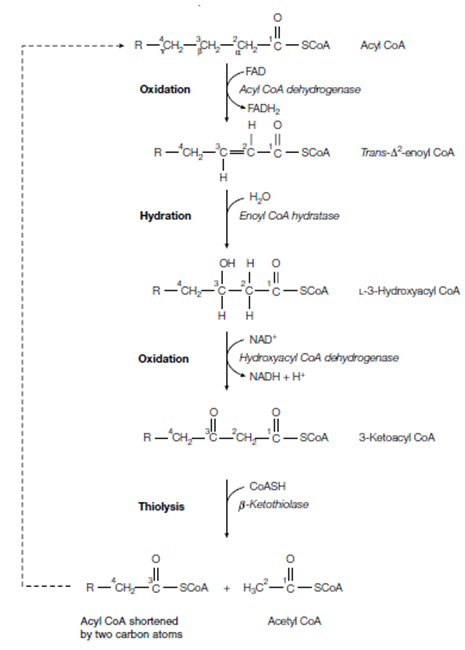ß-Oxidation pathway:
An individual reaction included in the degradation of fatty acids through β- oxidation is as bellows:
1. Oxidation of the fatty acyl CoA to enoyl CoA forming a trans Δ2-double bond on the fatty acyl chain and producing FADH2 (catalyzed through acyl CoA dehydrogenase).
2. Hydration of the trans Δ2-enoyl CoA to form 3-hydroxyacyl CoA (catalyzed through enoyl CoA hydratase).
3. Oxidation of 3-hydroxyacyl CoA to 3-ketoacyl CoA producing NADH (catalyzed through hydroxyacyl CoA dehydrogenase).
4. Cleavage, or thiolysis, of 3-ketoacyl CoA through a second CoA molecule, providing acetyl CoA and an acyl CoA shortened by two carbon atoms (catalyzed through β- ketothiolase).
Thus, the breakdown of individual fatty acids occurs as a repeating sequence of four reactions: oxidation (through FAD), hydration, oxidation (by NAD+) and thiolysis. These four reactions form one 'round' of fatty acid degradation and their whole effect is to erased two-carbon units sequentially in the form of acetyl CoA from the fatty acid chain. The cleavage of the Δ2 (or β) bond of the fatty acyl chain (top structure, for nomenclature) provides fatty acid breakdown its other name, β-oxidation. The reduced acyl CoA then undergoes further cycles of β-oxidation until the final cycle when the acyl CoA with four carbon atoms is dividing into two molecules of acetyl CoA. Thus a C16 saturated acyl CoA, like as palmitoyl CoA, would be completely degraded into eight molecules of acetyl CoA through seven rounds of degradation, leading to the whole equation:

Mitochondria hold three acyl CoA dehydrogenases that act on medium- short- and long-chain acyl CoAs correspondingly. In compare, there is just one each of the enzymes hydroxyacyl CoA dehydrogenase, enoyl CoA hydratase and β-ketothiolase that all have a wide specificity with respect to the length of the acyl chain.

Figure: Summary of the reactions involved in the degradation of fatty acids.
In animals the acetyl CoA produced from fatty acid degradation cannot be converted into oxaloacetate or pyruvate. Although the two carbon atoms from acetyl CoA enter the citric acid cycle they are both oxidized to CO2 in the reactions catalyzed through isocitrate dehydrogenase and α-ketoglutarate dehydrogenase. Thus, animals cannot convert fatty acids into glucose. In compare, plants have two further enzymes, isocitrate lyase and malate synthase, which enable them to convert the carbon atoms of acetyl CoA into oxaloacetate. This is accomplished via the glyoxylate pathway, a route including enzymes of both the mitochondrion and the glyoxysome and a specialized membranous plant organelle.